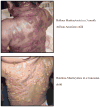Diagnosis and treatment of cutaneous mastocytosis in children: practical recommendations
- PMID: 21668033
- PMCID: PMC4126834
- DOI: 10.2165/11588890-000000000-00000
Diagnosis and treatment of cutaneous mastocytosis in children: practical recommendations
Abstract
Cutaneous mastocytosis in children is a generally benign disease that can present at birth and is often associated with mast cell mediator-related symptoms including pruritus, flushing, and abdominal pain with diarrhea. The most common form of presentation is urticaria pigmentosa, also referred to as maculopapular mastocytosis. Flares of lesions are induced by triggers such as physical stimuli, changes in temperature, anxiety, medications, and exercise. The skin lesions are typically present on the extremities. Symptoms respond to topical and systemic anti-mediator therapy including antihistamines and cromolyn sodium. Remission at puberty is seen in a majority of cases. Progression to systemic mastocytosis with involvement of extracutaneous organs is not common. The cause of cutaneous mastocytosis is unknown and familial cases are rare. Mutations of c-kit have been observed in the skin of those affected. The diagnosis is established on clinical grounds and the findings on skin biopsy. Bone marrow studies are recommended if there is suspicion of progression of disease to an adult form, if cytoreductive therapy is contemplated, or if skin lesions remain present and/or tryptase levels remain elevated after puberty. The use of chemotherapy, including kinase inhibitors, is strongly discouraged unless severe hematologic disease is present, since malignant evolution is extremely rare.
References
-
- Nettleship J, Tay W. Rare forms of urticaria. Br Med J. 1869;2:323–4.
-
- Sangster A. An anomalous mottled rash, accompanied by pruritus, factitious urticaria and pigmentation, “urticaria pigmentosa (?)”. Trans Clin Soc London. 1878;11:161.
-
- Ellis J. Urticaria pigmentosa: a report of a case of autopsy. Arch Pathol. 1949;48:426–35. - PubMed
-
- Degos R. Urticaria pigmentosa and other types of mastocytosis; attempted classification of cutaneous mastocytoses. Actas Dermosifiliogr. 1955;46:759–85. - PubMed
-
- Valent P, Horny H-P, Escribano L, et al. Diagnostic Criteria and Classification of Mastocytosis: A Consensus Proposal. Leuk Res. 2001;25:603–25. - PubMed
Publication types
MeSH terms
Grants and funding
LinkOut - more resources
Full Text Sources




